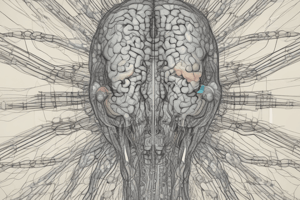Podcast
Questions and Answers
What are the two primary components of the nervous system?
What are the two primary components of the nervous system?
Central nervous system (CNS) and peripheral nervous system (PNS)
What is the primary function of the CNS?
What is the primary function of the CNS?
To control and coordinate body functions
What are the three crucial processes in which the CNS plays a role?
What are the three crucial processes in which the CNS plays a role?
Cognition, motor control, and sensory processing
What does the peripheral nervous system (PNS) connect the CNS to?
What does the peripheral nervous system (PNS) connect the CNS to?
What are the two subdivisions of the peripheral nervous system (PNS)?
What are the two subdivisions of the peripheral nervous system (PNS)?
What is the function of the autonomic nervous system (ANS)?
What is the function of the autonomic nervous system (ANS)?
What is the main function of the somatic nervous system (SNS)?
What is the main function of the somatic nervous system (SNS)?
Describe the process of neurotransmission in neurons.
Describe the process of neurotransmission in neurons.
What are the three main parts of a neuron?
What are the three main parts of a neuron?
Explain the role of reflexes in the nervous system.
Explain the role of reflexes in the nervous system.
What is the function of the autonomic nervous system (ANS)?
What is the function of the autonomic nervous system (ANS)?
What is the primary function of motor control?
What is the primary function of motor control?
How do neurons transmit electrical signals away from the cell body?
How do neurons transmit electrical signals away from the cell body?
What is the role of neurotransmitter release in neurotransmission?
What is the role of neurotransmitter release in neurotransmission?
Why are reflexes considered important for the body?
Why are reflexes considered important for the body?
What are the two main types of nervous systems mentioned in the text?
What are the two main types of nervous systems mentioned in the text?
Flashcards are hidden until you start studying
Study Notes
Neural control and coordination are essential processes in the human body, enabling us to perform various tasks and maintain balance and posture. The nervous system is responsible for these functions, and it is composed of two primary components: the central nervous system (CNS) and the peripheral nervous system (PNS).
Central Nervous System (CNS)
The CNS consists of the brain and spinal cord and serves as the primary center for controlling and coordinating body functions. It receives, processes, and transmits information through a complex network of neurons and neurotransmitters. The CNS plays a crucial role in various processes, such as:
- Cognition: The CNS is responsible for processing information, making decisions, and understanding the world around us.
- Motor control: It controls and coordinates muscle movements to perform tasks and maintain balance.
- Sensory processing: The CNS processes sensory information from the environment and internal body systems.
Peripheral Nervous System (PNS)
The PNS is composed of nerves that connect the CNS to the rest of the body, including muscles and organs. It is responsible for transmitting signals between the CNS and the effector organs, such as muscles and glands. The PNS has two subdivisions: the somatic nervous system (SNS) and the autonomic nervous system (ANS).
- Somatic nervous system (SNS): The SNS controls voluntary movements and sensations of the skeletal muscles.
- Autonomic nervous system (ANS): The ANS controls involuntary responses, such as heart rate and digestion.
Neurotransmission
Neurotransmission is the process by which neurons communicate with each other. This process involves several steps:
- Action potential: The nerve cell generates an electrical pulse called an action potential, which travels down the axon.
- Neurotransmitter release: The action potential triggers the release of neurotransmitters from the axon terminal.
- Synaptic cleft: The neurotransmitters diffuse across the synaptic cleft, the narrow space between the axon terminal and the dendrite of the next neuron.
- Binding to receptors: The neurotransmitters bind to receptors on the next neuron, altering its electrical properties and potentially initiating an action potential.
- Reuptake or degradation: The neurotransmitters are either taken back up by the axon terminal (reuptake) or broken down by enzymes in the synaptic cleft.
Neuron Anatomy and Physiology
Neurons are the fundamental building blocks of the nervous system and are responsible for transmitting electrical and chemical signals. They consist of three main parts:
- Cell body: Contains the nucleus and most of the cell's cytoplasm.
- Dendrites: Receive and transmit electrical signals from other neurons.
- Axon: Transmits electrical signals away from the cell body.
Neurons use a variety of mechanisms to transmit signals, including ion channels and neurotransmitters.
Reflexes and Motor Control
Reflexes are rapid, automatic responses to stimuli, which help protect the body from harm and maintain balance. They are initiated by sensory receptors and involve a coordinated response from the CNS and effector organs, such as muscles.
Motor control refers to the process of planning and executing movements. It involves the CNS, PNS, and effector organs, such as muscles. Motor control is essential for performing various tasks, maintaining balance, and coordinating movements.
In conclusion, the neural control and coordination processes are complex and involve the interactions between the CNS, PNS, reflexes, and motor control mechanisms. These processes enable us to perform various tasks and maintain our overall well-being.
Studying That Suits You
Use AI to generate personalized quizzes and flashcards to suit your learning preferences.




